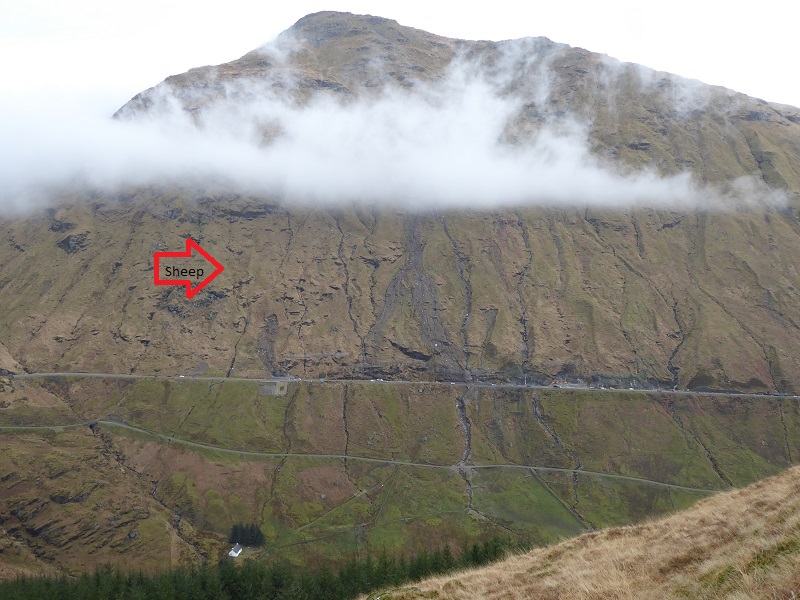
Here’s a prediction. There will be no rest and no thanks to the Scottish Government for as long as they allow the current mismanagement of the Rest and Be Thankful to continue and they fail to invest money in a long-term solution. That prediction and this post is prompted by the sheep spotted grazing on the slopes of Beinn Luibhean last Sunday.
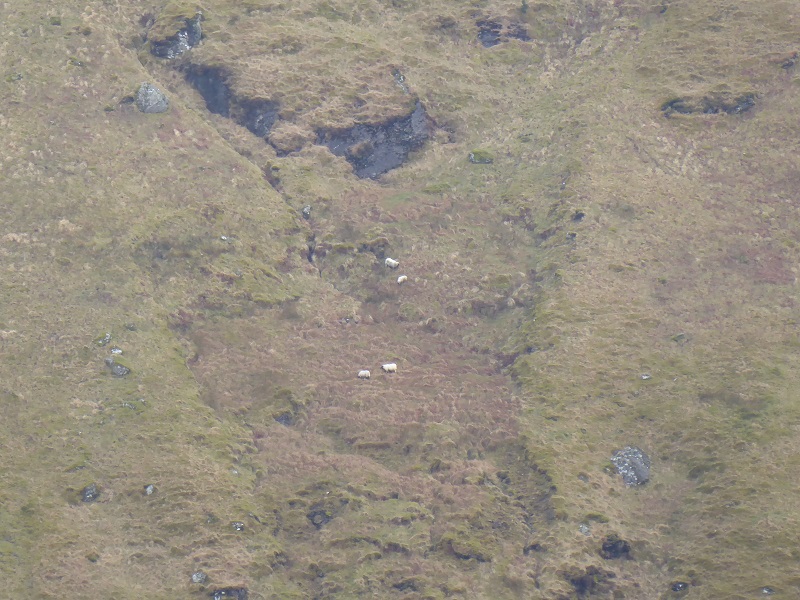
Why sheep are still being allowed to graze these slopes is beyond comprehension.
Yes, there are only four, but it is now seven years since it was OFFICIALLY acknowledged, in response to a report from Forest Research in 2012, that the grazing by sheep and deer of the south facing slopes of Beinn Luibhean was contributing to the instability of the slope. That report recommended that woodland restoration/planting would ameliorate the problem. In other European countries public authorities have accepted that overgrazed slopes in mountain areas are a major factor in avalanches and landslips for well over 100 years and have taken action. In Scotland, however, this is still not taken seriously.
The creation of the A83 taskforce, chaired by the Scottish Transport Minister, appears to have made little or no difference to the rate of progress. Minutes of the Taskforce (see here) show that it was agreed in March 2017 that a planting “trial” would go ahead. It was then reported that:
Work is now underway in partnership with Forest Enterprise Scotland (FES), who manage the National Forest Estate on behalf of Forestry Commission Scotland, to source the required local provenance native tree species that will form the basis of the new woodland to be established on the steep slopes of Beinn Luibhean above the A83. It is hoped that planting will commence in spring 2018.
After the latest landslides last October, the Express reported that that work won’t start till 2020 (see here). Meantime, it appears, grazing of the hillside will continue. Unbelievable!
The role of the Loch Lomond and Trossachs National Park
Part of the explanation for the failures at the Rest and Be Thankful is the weakness of the Loch Lomond and Trossachs National Park Authority. They weren’t even present at the October 2017 and March 2018 taskforce meetings (and no apologies were recorded). While the LLTNPA have made representations in the past about the landscape impact of the landslip mitigation measures at the Rest and Be Thankful and given support to the idea of woodland restoration, they appear to have done very little to make this happen.
In my view the A83 through the Rest and Be Thankful and Glen Kinglas needs to be considered within the context of a land-use plan for Arrochar as a whole, everything from the future of the conifer plantations to footpaths Mountaineering Scotland called for this back in 2013, in response to Forest Enterprise’s Forest Plan for Glen Croe (see here), but nothing has happened:
“MCofS would welcome a general reduction in the levels of grazing across the wider area in order to encourage biodiversity, including a scrub layer at the top of the forest plantations. This would not be possible in the Glen Croe Forest District alone, but would have to be implemented across a wider area. A significant reduction in grazing on the south western slopes of Beinn Luibhean would encourage regeneration on that side of the mountain, which in turn could help to stabilise the slopes that are currently prone to landslides. The only way to address these bigger issues is via a plan for a much wider area, so the MCofS would like to see FCS, LLTNPA, SNH and other bodies working together to formulate a plan for the whole of the Arrochar Alps.”
We need a strong National Park to lead on this but instead there is no-one articulating the need to consider the management of the A83 within the context of ecological process, the landscape or the cultural significance of the Rest and Be Thankful.
The effectiveness of current mitigation works
The Scottish Government has undertaken three main measures to try and address the the landslip problems at the Rest and Be Thankful, upgrading the old road as an alternative route should the A83 be blocked, the installation of wire netting and more recently the creation of three debris traps. Whether or not you agree with these measures, there is plenty of evidence to show that they have not been progressed as vigorously as one might have expected, with references in the minutes to resources being diverted to address issues elsewhere and with progress reports being pasted into the minutes from one year to the next, spelling mistakes and all:
JW explained that discussions are to take place with the landowner at Glen Kinglas about re-using the excavated material from Rest and Be Thankful to create bunds in Glen Kinglas to protect the trunk road form (sic) the risk of landslides which have occurred previously and closed the A83. (March 2017 minute)
JW explained that discussions are to take place with the landowner at Glen Kinglas about re-using the excavated material from Rest and Be Thankful to create bunds in Glen Kinglas to protect the trunk road form (sic) the risk of landslides which have occurred previously along this stretch and closed the A83. (March 2018 Minute)
I would not blame the officials involved for this. There is clearly a lack of resources, including the resources needed to manage the “project” properly. When the Minister is at meetings, they often start with a statement of how much money is or has been spent on the A83:
The Minister reminded all of the £58M that has been invested in the A83 since 2007 up to the end of the last financial year. This includes £9.6M towards reducing the risk of impacts from landslides at the Rest and Be Thankful and the establishment of the local diversion route, which helps keep Argyll open for business.
Rather than trying to address the problems, the whole focus of the civil servants involved is on managing inadequate resources.
Considerable financial investment of public funds to initiate the project, secure the required land, provide the necessary deer fencing and establish and maintain the planting. This is estimated at £1.2M and a further estimated value of £200k for on-going maintenance costs.
The Minister stated that there should not be a fear of trying new things or being innovative as long as due diligence has been taken.
£1.2m should be seen as a paltry amount – think of the A9 dualling project – but is portrayed as being considerable. What price prevention and what hope for the Scottish Government’s aspiration to increase forest cover in Scotland?
What the taskforce never does is articulate what resources are really be needed to address the problems of the A83 at the Rest and Be Thankful long-term.
Why the current mitigation measures are unlikely ever to work
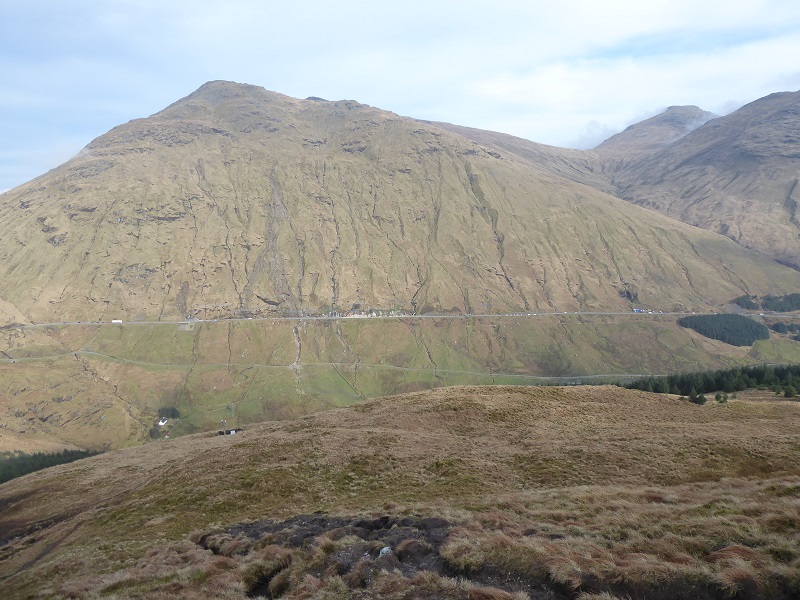
The fundamental problem with the A83 is well illustrated from the north ridge of Ben Donich. The road cuts straight across a steep glacially carved slope which is covered in glacial debris. The slope is rather similar to that of Ben Dorain at Bridge of Orchy – imagine cutting a road across that, yet that is what has been done on Beinn Luibhean.
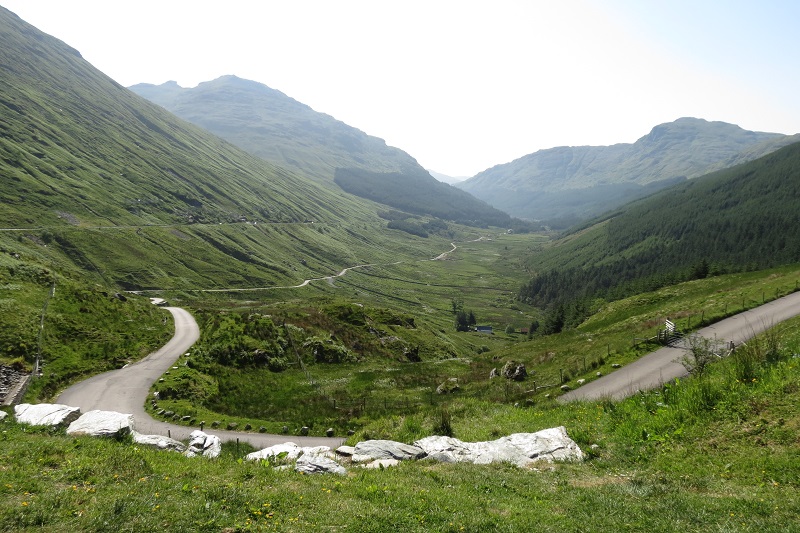
While trees would make a difference to the rate of erosion on the slope, its steepness and the nature of the rock beneath the glacial debris is such that landslips are certain to continue whatever preventive measures are put in place. Looking down Glen Croe the relative steepness of Beinn Luibhean compared to the conifer planted slopes of Ben Donich is obvious. Routeing the A83 along the other side of the glen would have made more sense, even if snow lie there (its north facing) might be more of an issue.
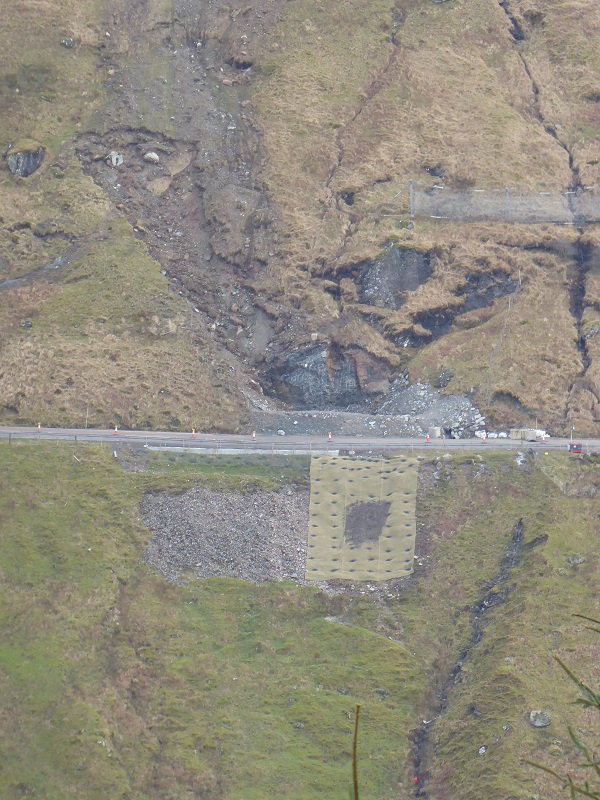
Coupled with the steepness of the slope is the sheer volume of glacial debris that covers the hard mica schists excavated by the glacier which underly them. Extensive engineering is needed to try and secure/make safe just one small section of the slope.
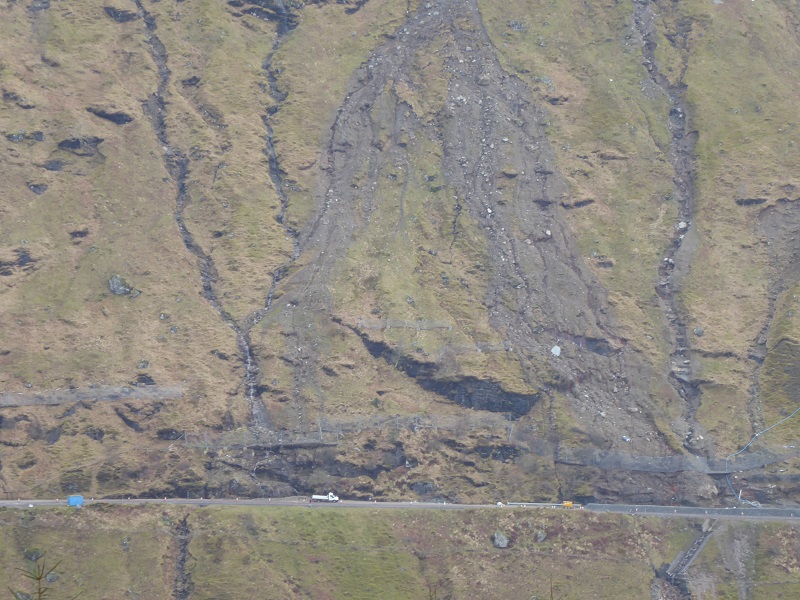
The netting is unlikely to be ever sufficient to prevent larger debris flows reaching the road – a really large flow will simply run over the top – and creates a problem because the build up behind the netting puts it under considerably tension. This then needs to be removed if future flows are not to run over the top. Its as a consequence of this problem that the Scottish Government has now commissioned debris traps by the road which would be much easier to empty. Creating a trap the whole way along this section of road, however, poses a considerable challenge. There is not enough space due to the steepness of the slope.
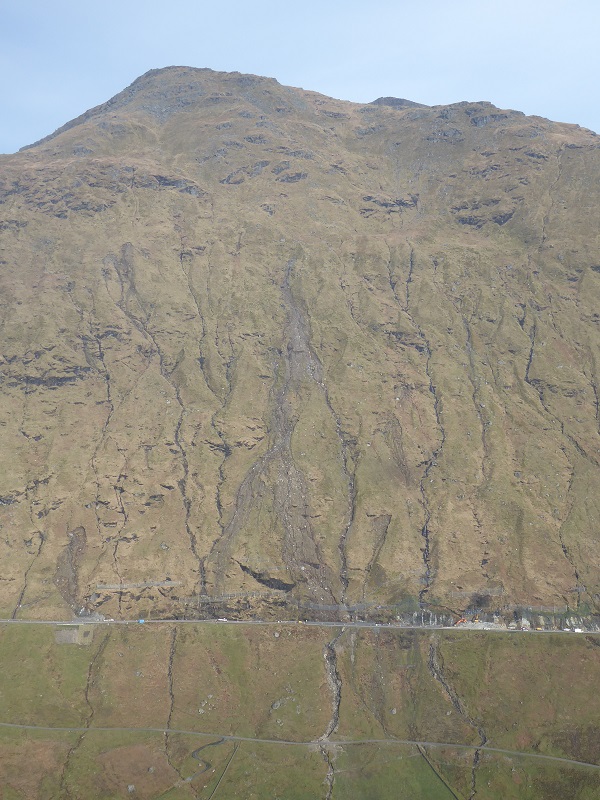
The problem is accentuated further by the nature of the ground above the main glacial debris covered slope. A large hollow, possibly created by the beginnings of a coire glacier, lies above. Moss and peat form here, in contrast to the steep slopes below. This holds the water but in times of heavy rainfall it can be suddenly released. That then acts rather like the hush dams which were used near Tyndrum to prospect for lead and other metals. The rush of water sweeps away the vegetation and debris below.
What are the solutions to the A83 at the Rest and Be Thankful?
In the face of these challenges, I cannot see the current engineering works at the Rest and Be Thankful ever working, whatever the skill of the staff involved (and I am not underestimating what it has taken to do the work so far or the efforts that have been made to clear the road in very difficult conditions). The issue is the Scottish Government is locked into the wrong solutions, mainly I believe because its not prepared to spend the money that is required to tackle the cause of the problems which is the alignment of the road across what is fundamentally an unstable hillside which was never suitable for a road.
The choice is whether we continue to wreck the Rest and Be Thankful further, through incremental engineering solutions or by covering the road over so the landslips flow over the top, or whether we re-align the road either on the other side of the glen or, what they would do in Europe, by tunnelling it under the Arrochar Alps. I would like to see the Loch Lomond and Trossachs National Park Authority promoting the need for that debate and facilitating it within the context of a plan for the whole area. The grazing sheep should be a wake-up call
I recall using the A83 Rest & Be Thankful regularly for hillwalking and Munro bagging in the late 1960s and early 1970s – winter and summer. I do not recall any problems with landslides then. It would be interesting to compare photos from that era taken from opposite slopes of Glen Croe with the ones in this article. I suspect that the steep hillside has become much more eroded and rutted than it was in the 1960s and 1970s.
I agree with you, Nick, that the Scottish Government is ineffectively trying to treat the symptoms of the problem, rather than solving the causes. When will Transport Scotland, Scottish Government ministers and LLTNPA waken up and stop wasting our money on ineffective ‘sticking plaster’ solutions.
I recall a landslide on “The Rest” when my mother hired a bus for friends to take them to The Cowal Games in Dunoon and I was about 24 then in 1960. Is the Government waiting for a very tragic accident to happen on this road? Why couldn’t a bridge? road have been built over the old road, or is that too sensible an idea. It probably would have been much cheaper.
Why do Governments always insist on wasting tax payers money?
Thanks for the post, Nick. Do you know if sheep continue to graze on Beinn Luibhean?
Whilst reducing grazing is not a solution in itself, it is certainly a start. I have been looking for old photos of the Rest and came across this one (undated) but appears to be 1920’s/30’s. What seems absent are the trees below as well as no obvious signs of landslips.
https://www.facebook.com/ambaile/photos/a.10150722242376172/10151666421131172/?type=3&is_lookaside=1
Hi Nick, I haven’t had a chance to look this year so I don’t know. Photo is fantastic, thanks.
Landslides of this type are common in the Alps. The solution is, build an avalanche gallery over the affected sections of the road. It’s effectively a roof. When a landslip occurs the debris just slides over the roof and the road is protected. They are everywhere in the Alps.